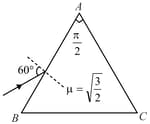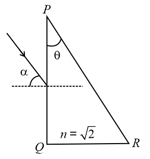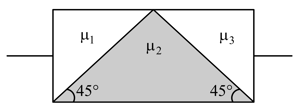HARD
Earn 100
A ray of light falls on right angled isosceles prism having refractive index as shown in figure


(a)The ray inside the prism is parallel to base of prism
(b)Total deviation suffered by the light ray is
(c)Total deviation suffered by the light ray is
(d)The angle of emergence is
52.94% studentsanswered this correctly
Important Questions on Ray Optics and Optical Instruments
HARD

HARD
EASY
EASY
MEDIUM
EASY
MEDIUM
EASY
MEDIUM
EASY
HARD
EASY

HARD
HARD
A rectangular block is composed of three different glass prisms (with refractive indices ) as shown in the figure below. A ray of light incident normal to the left face emerges normal to the right face. Then the refractive indices are related by

EASY
EASY
MEDIUM
EASY
EASY
EASY

